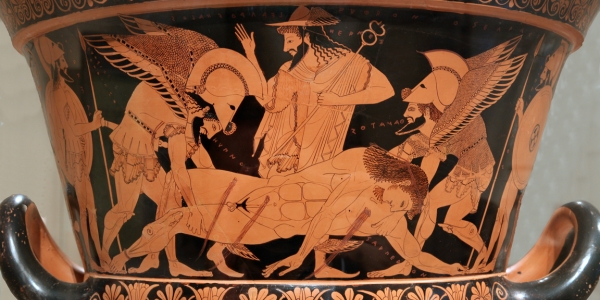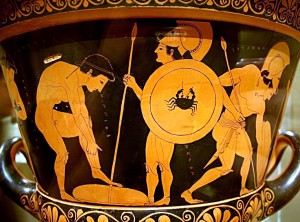
January 23, 2014, by Richard Rawles
Sarpedon: Looking at the Past
The pot in the picture is a big (about 45 cm tall) krater (mixing bowl for wine), manufactured in Athens in the late sixth century BC. We know the name of the potter (Euxitheos) and the painter (Euphronios), because both are named on the pot (one signature reads ‘Euxitheos made me’ and another ‘Euphronios painted me’). As we’ll see, we also know something of its history since it was made.
I have been thinking about this recently because I included a seminar on ‘reception’ in my undergraduate module on the Homeric Iliad. The pot was a natural one to choose for part of that seminar, because the scene depicted seems to relate quite closely to a great moment in book 16 of the poem: Zeus’ mortal son, Sarpedon, is killed by Achilles’ companion Patroclus, shortly before Patroclus comes to his own death at the hands of Apollo and Hector. Even though Zeus pities his son, he is persuaded by his wife Hera not to intervene to save him – but he does provide Sarpedon with a burial at home, by sending Apollo to recover the corpse, wash it, and hand it over to Sleep and Death, who take it to Sarpedon’s homeland of Lycia for burial.
I asked the students to look at the image and to think about how it related to the passage in the Iliad, how it was different, and why, and to consider what this might mean for Athenians looking at the pot in the late sixth century. As is common with reception, this took me a bit out of my comfort zone (I am definitely a Literature Person, and late sixth century pottery – any pottery, come to that – is not where I feel most at ease; on the other hand, I am very interested in literary receptions of Homer around this period, especially in the work of the poet Simonides, who has occupied a great deal of my research thinking for some years). Anyway, I needn’t have worried, since the students (and my tremendous teaching assistants, who have four of the five seminar groups) did very well, and talked to me in intelligent and interesting ways about why Hermes in this image might have been made to stand in for Apollo in the Iliad, about how an Athenian viewer might have related the depiction of Sarpedon to that of the contemporary Athenian warriors (if that is what they are) on the other side of the pot [see below], and about the way in which the artist has concentrated our attention on Sarpedon’s lovingly depicted corpse, shockingly marred by the bold red diagonals of blood from his wounds.
This was all very interesting, and I hope the students thought so too, but (there were Constraints Of Time: there always are!) we were focusing on only one part of the story: in fact, we can talk about a lot of different moments of reception by thinking about this one object.
Story 1: Euphronios painted the scene some time in the late sixth century (we would like to know, for instance, whether this was before or after the reforms of Cleisthenes, which established the first phase of the Athenian democracy, but as far as I know the dating is not specific enough for that). So we can ask questions about him as a painter, and about his client(s) and the viewers of the pot in late archaic Athens. How did they respond to a reminder of the Iliad at their drinking party (by this time, they probably knew the Homeric poems through competitive recitations by rhapsodes at the Panathenaic festival)? How did they relate the picture of beautiful, doomed Sarpedon to the images of similarly young and beardless soldiers on the other side? This story does not end here, because we now know that this pot found its way to central Italy, where it was buried in the tomb of a high-status member of that fascinating group we call the Etruscans. This is by no means an uncommon story: the Etruscans imported Greek pottery in large quantities, and often used pots as grave goods. Another question opens up (one which I personally know almost nothing about): how did some un-named Etruscans look at this pot? Did they know who Sarpedon was? Could they read the Greek inscriptions? Were they aware of how the story of Sarpedon’s Zeus-sanctioned burial suited the pot’s new status as part of the content of a tomb? Here we can move on to another story…
Story 2: I first became aware of this pot when I was an undergraduate at University College London. One of my teachers – one of the teachers who was most important for me as an undergraduate and during my doctoral research – had a poster of it on the wall. I can remember very clearly hearing him speaking about it. At that time, the pot was in the Metropolitan Museum of Art in New York, and that was where I first saw it in the flesh, during my first and only trip to that great city and great museum. The Met had acquired the pot in the 1970s for what was then a very high price, but it now seems clear that it had not been imported into the USA in a way which respected international heritage agreements. When I saw the pot, its label already acknowledged that the pot was now the property of the Republic of Italy. The second time I saw the pot was this summer, in the Museo Nazionale Etrusco in the Villa Giulia in Rome [see http://www.villagiulia.beniculturali.it ]. Now it has its place in the astonishingly wonderful collection of Greek (i.e., Greek manufactured) pottery in Rome’s Etruscan Museum. It is now displayed in a context which reminds us of its intermediate history among those mysterious Etruscans.
So all of this was in my mind when I talked about the pot, first with my TAs and then with my students. Since then, however, I thought about the pot again, partly because I had in mind to write this blog as a response to a suggestion from my colleague Helen Lovatt. At this point, it became natural for me to think about what Helen’s approach to the pot might be, and I was thinking about this in the knowledge that Helen has recently published an important book about vision and the gaze in epic poetry [http://www.cambridge.org/gb/academic/subjects/classical-studies/classical-literature/epic-gaze-vision-gender-and-narrative-ancient-epic]. The original scene in the Iliad is of some interest in relation to this subject. We see Sarpedon from the point of view of Zeus, up on Olympus: he looks down, and he pities (but he does not save him). For viewers of the pot, this gaze seems to me to be re-configured in important ways. We see Sarpedon as if from his own level, and his body is carefully framed and exposed to us (it is also very big, as one of the students in my seminar group rightly emphasised to me: if he were standing, he would be much taller than Hermes). We can sense the artist’s close attention to the detail of his body, especially with the musculature of the chest and arms, and the carefully painted (and gravity-resistant) hair. How does an Athenian wine-drinker see this? How eroticised is the image? Beside Hermes’ head is a surprising inscription: ΛΕΑΓΡΟΣ ΚΑΛΟΣ (Leagros kalos, ‘Leagros is beautiful’). The painter includes a little ‘tag’ (these are common on pottery from Athens in this period) commemorating the beauty of a contemporary young male heart-throb. Was this prompted by recognition that the pot is, among other things, about acknowledgement of the youthful body as object of desire? And what does that desire have in common with our feelings when we look at the past, whether we think of curators who really want to own this glorious pot, or whether I think of myself and the history of my own encounters with Euphronios’ Sarpedon, first focalised through my experience as an undergraduate?
So I am glad that I decided to include this pot as one of my examples of Iliad reception. Not only did the students like it, but I think it provokes reflection on the different ways we can approach the past, and on the way in which our own reception stories condition our feelings about the texts and objects we study, and about the unpredictable and valuable ways in which participation in research communities can prompt the questions we ask.
I think my next task is to go to the library, find Helen’s book, and find out whether she did discuss the death of Sarpedon, and if so, what she said about it.
For more on Richard’s research and teaching, see http://nottingham.ac.uk/classics/people/richard.rawles
Image credits: 1. Sarpedon’s body carried by Hypnos and Thanatos (Sleep and Death), while Hermes watches. Side A of the so-called “Euphronios krater”, Attic red-figured calyx-krater signed by Euxitheos (potter) and Euphronios (painter), ca. 515 BC. H. 45.7 cm (18 in.); D. 55.1 cm (21 11/16 in.). Formerly in the Metropolitan Museum of Art, New York (L.2006.10); Returned to Italy and exhibited in Rome as of January, 2008. Photo by Jaime Ardiles-Arce. Source: Wikimedia commons. http://en.wikipedia.org/wiki/File:Euphronios_krater_side_A_MET_L.2006.10.jpg accessed 23.01.2014
Image credits: 2. Athenian youths arming themselves. Side B of the so-called “Euphronios krater”, Attic red-figured calyx-krater signed by Euxitheos (potter) and Euphronios (painter), ca. 515 BC. H. 45.7 cm (18 in.); D. 55.1 cm (21 11/16 in.). Metropolitan Museum of Art, New York (L.2006.10). Photo by Rolf Müller. Source: Wikimedia commons. http://en.wikipedia.org/wiki/File:Euphronios_krater_side_B_MET_L.2006.10.jpg accessed 23.01.2014
No comments yet, fill out a comment to be the first


Leave a Reply